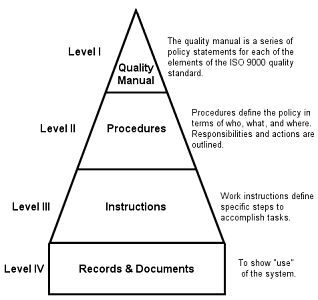 Two days ago I wrote that every SME should have written procedures, but how to start? Who should write them? What format to follow?
Two days ago I wrote that every SME should have written procedures, but how to start? Who should write them? What format to follow?
The majority of articles and manuals available focus on large companies. I tried to write advice applicable by most SMEs in the paragraphs below.
Who should write procedures?
The best practice is usually to select one smart employee who can write in a concise and precise manner. Make it this employee’s first priority, and if possible involve a consultant to give him feedback early on.
As Colin Gray writes in Quality Management: ISO 9000 Documentation Structure and Tools:
The person writing the procedures must ensure that the process is accurately depicted. This is typically done by interviewing the staff in the area for which the procedure is being written. The interview is used to gather needed information about the process and to determine how compliant the process is. It also allows the staff to have input into the procedure, so they don’t feel “out of the loop” and can feel “ownership” of the documents once created. From the information gathered in the interviews, the writer writes the procedure, reviews and edits it with the staff.
The three (or four) levels of documentation
If you start writing procedures for your company, you might as well make it consistent with ISO 9000’s requirements. And it will help you make it more readable!
Again, Gray gives excellent advice:
It is very important that the documentation be structured using three levels. Level one consists of the Quality Policies. This usually takes the form of a Quality Manual. Level two consists of the standard operating procedures. Level three refers to the work instructions, checklists, forms, and other task specific documentation.
 Level I (the first thing to write): the 10,000 feet view of what happens in the company: how it is organized, who is responsible for what, and the basic structure of the quality system.
Level I (the first thing to write): the 10,000 feet view of what happens in the company: how it is organized, who is responsible for what, and the basic structure of the quality system.
Level II: the 2,000 feet view: who is supposed to do what, on the basis of what information, under whose supervision.
Level III: very close to the ground: the detailed tasks, the checklists, and templates of forms to fill out. It includes all the small details that would make level II too heavy to ready quickly. For example, the QC checklist that buyers write for every one of their products.
Level IV: records of recent forms that prove the quality system is really used by the staff.
Remark: if you are thinking of using an ERP, or building a custom IT system for your company, try hard to complete levels I and II first.
General advice on formatting
Most of the staff should be able to read the procedures and understand them easily. Here is my advice:
- Start by drawing flow charts. Many employees don’t like to read (not to mention the Chinese staff with limited English proficiency). Make the content as visual as possible.
- Show everything you can in a flow chart, but don’t try to show it all in one single chart (follow the logic of the levels described above). At the most, one chart should contain in an A4 page and should still be easily legible (no small font).
- Write the text in bullet points rather than in paragraphs.
- Avoid complex jargon or long and complex sentences.
- The first level (quality manual) should be 8-10 pages maximum, unless your organization is particularly complex.
If you follow these guidelines, you are the right way to be ISO-9001 certified. Make sure you get feedback from your registrar on how to improve your quality system, and some work with a consultant may well still be necessary…
Anybody has other tips to share?

I think social code certificate is difficult than ISO 9001.
An SA 8000 certification? Oh yes, much more difficult to obtain.